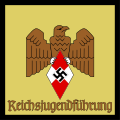Reichsjugendführer
Reichsjugendführer ("National Youth Leader") was the highest paramilitary rank of the Hitler Youth.[1] On 30 October 1931, Hitler appointed Baldur von Schirach as the Reich Youth Leader of the Nazi Party.[2] In 1933, after the Nazi seizure of state power, all youth organizations in Germany were brought under Schirach's control[3][4] and he was designated the Jugendführer des Deutschen Reiches on 17 June.[5] When Schirach was named Gauleiter of the Reichsgau Vienna on 8 August 1940, Artur Axmann succeeded him as Reichsjugendführer.[6] Axmann had served as Schirach's deputy since 1 May 1940.
| National Youth Leader
Reichsjugendführer | |
|---|---|
 Reichsjugendführer gorget patch | |
 Standard for the Reichsjugendführer | |
| Nazi Party | |
| Status | Abolished |
| Abbreviation | RJF |
| Member of | |
| Appointer | Führer of the NSDAP |
| Formation | 1931 |
| First holder | Baldur von Schirach |
| Final holder | Artur Axmann |
| Abolished | 1945 |
| Deputy | |
List
| No. | Reichsjugendführer | Took office | Left office | Time in office | |
|---|---|---|---|---|---|
| 1 | Baldur von Schirach (1907–1974) | 30 October 1931 | 8 August 1940 | 8 years, 283 days | |
| 2 | Artur Axmann (1913–1996) | 8 August 1940 | 8 May 1945 | 5 years, 7 days |
Post-war
With the surrender of Nazi Germany, the Hitler Youth was disbanded by Allied authorities as part of the denazification process. Both Schirach and Axmann were condemned as war criminals by the leading Allies powers after the end of the Second World War in Europe, in particular for the role the two played in corrupting the minds of children.[7] Schirach was sentenced to 20 years in prison.[8] Axmann only received a 39-month prison sentence in May 1949.[9] Later, in 1958, a West Berlin court fined Axman 35,000 marks (approximately £3,000, or $8,300 USD), about half the value of his property in Berlin. The court found him guilty of indoctrinating German youth with National Socialism until the end of the war.[9]
References
Notes
- McNab 2009, p. 15.
- Zentner & Bedürftig 1991, pp. 431, 835.
- Zentner & Bedürftig 1991, p. 431.
- Kater 2004, pp. 48–59.
- Hoffkes 1997, p. 299.
- Hamilton 1984, pp. 247, 334.
- Hamilton 1984, pp. 247, 335.
- Rempel 1989, pp. 250–251.
- Hamilton 1984, p. 248.
Bibliography
- Hamilton, Charles (1984). Leaders & Personalities of the Third Reich, Vol. 1. San Jose, CA: R. James Bender Publishing. ISBN 0-912138-27-0.CS1 maint: ref=harv (link)
- Höffkes, Karl (1997). Hitlers Politische Generale: Die Gauleiter des Dritten Reiches. Tübingen: Grabert-Verlag. ISBN 3-87847-163-7.CS1 maint: ref=harv (link)
- Kater, Michael H. (2004). Hitler Youth. Cambridge, MA: Harvard University Press. ISBN 0-674-01496-0.CS1 maint: ref=harv (link)
- McNab, Chris (2009). The Third Reich. Amber Books Ltd. ISBN 978-1-906626-51-8.CS1 maint: ref=harv (link)
- Rempel, Gerhard (1989). Hitler's Children: The Hitler Youth and the SS. Chapel Hill, NC: University of North Carolina Press. ISBN 978-0-8078-4299-7.CS1 maint: ref=harv (link)
- Zentner, Christian; Bedürftig, Friedemann (1991). The Encyclopedia of the Third Reich. (2 vols.) New York: Macmillan Publishing. ISBN 0-02-897500-6.CS1 maint: location (link) CS1 maint: ref=harv (link)
.jpg)
.jpg)